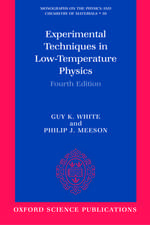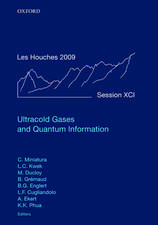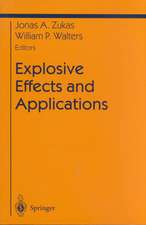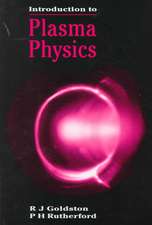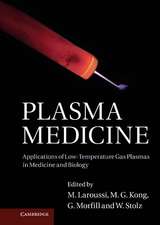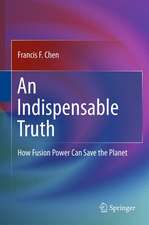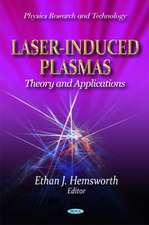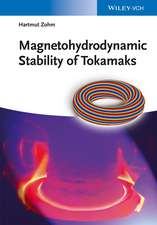Physics of High-Density Z-Pinch Plasmas
Autor Michael A. Liberman, John S. De Groot, Arthur Toor, Rick B. Spielmanen Limba Engleză Hardback – 21 mai 1999
| Toate formatele și edițiile | Preț | Express |
|---|---|---|
| Paperback (1) | 640.24 lei 43-57 zile | |
| Springer – 17 oct 2012 | 640.24 lei 43-57 zile | |
| Hardback (1) | 645.60 lei 43-57 zile | |
| Springer – 21 mai 1999 | 645.60 lei 43-57 zile |
Preț: 645.60 lei
Preț vechi: 759.54 lei
-15% Nou
Puncte Express: 968
Preț estimativ în valută:
123.57€ • 134.27$ • 103.87£
123.57€ • 134.27$ • 103.87£
Carte tipărită la comandă
Livrare economică 21 aprilie-05 mai
Preluare comenzi: 021 569.72.76
Specificații
ISBN-13: 9780387985688
ISBN-10: 0387985689
Pagini: 277
Ilustrații: VIII, 277 p.
Dimensiuni: 155 x 235 x 19 mm
Greutate: 0.56 kg
Ediția:1999
Editura: Springer
Colecția Springer
Locul publicării:New York, NY, United States
ISBN-10: 0387985689
Pagini: 277
Ilustrații: VIII, 277 p.
Dimensiuni: 155 x 235 x 19 mm
Greutate: 0.56 kg
Ediția:1999
Editura: Springer
Colecția Springer
Locul publicării:New York, NY, United States
Public țintă
ResearchCuprins
1. Introduction.- 1.1. An historical perspective.- 1.2. Characteristics of modern Z-pinch systems.- 1.3. The various types of Z pinches.- 1.4. Pulsed-power drivers.- 2. Equilibria of Z-Pinch Plasmas.- 2.1. Steady-state equilibria of Z-pinch plasmas.- 2.2. Equilibria of radiating Z pinches.- 3. Dynamics of Z-Pinch Plasmas.- 3.1. Formation of Z-pinch plasmas: Theoretical modeling.- 3.2. Zero-dimensional models of dynamic Z pinches.- 3.3. Fluid models of Z-pinch plasmas.- 3.4. Self-similar dynamics of an ideal MHD Z pinch.- 3.5. Self-similar solutions for time-dependent Z-pinch equilibria.- 4. Stability of Z-Pinch Plasmas.- 4.1. The stability of steady-state Z pinches.- 4.2. Effect of ohmic heating and radiative losses: Overheating instability and filamentation.- 4.3. Resistive and viscous effects on Z-pinch stability: Heat conductivity.- 4.4. Effects of finite and large ion Larmor radius: The Hall effect.- 4.5. Kinetic effects.- 4.6. Nonlinear evolution of the m = 0 mode.- 5. Rayleigh—Taylor Instability of a Plasma Accelerated by Magnetic Pressure.- 5.1. Rayleigh—Taylor instabilities of dynamic plasmas.- 5.2. Ideal MHD model: The Rayleigh—Taylor instability modes.- 5.3. Ideal MHD model: Effects of plasma compressibility and magnetic shear.- 5.4. Effect of magnetic shear.- 5.5. Dissipative effects.- 5.6. Large Larmor-radius effects.- 5.7. Nonlinear evolution of the Rayleigh—Taylor instability.- 6. Stability of Dynamic Z-Pinches and Liners.- 6.1. The thin-shell model.- 6.2. Growth of the RT instabilities in a layer of finite thickness.- 6.3. Rayleigh—Taylor instabilities in an imploding Z pinch: The snowplow model.- 6.4. Imploding wire arrays.- 6.5. Ideal MHD model.- 6.6. Stability of gas-puff Z-pinch implosions.- 6.7. Stabilization of long-wavelength sausage andkink modes of a Z pinch by radial oscillations.- 6.9. Two-dimensional simulation of magnetically driven.- Rayleigh—Taylor instabilities in cylindrical Z pinches.- 7. Applications of Z Pinches.- 7.1. Controlled nuclear fusion.- 7.2. Z pinches as sources of x-ray and neutron radiation.- 7.3. X-ray laser.- 7.4. Production of ultrahigh pulsed-magnetic fields.- 7.5. Focusing high-energy particles in an accelerator.- Conclusions.- References.
Caracteristici
Provides a comprehensive review of the physics of dense z-pinches * In addition to the theoretical treatment, the authors also discuss recent experimental results as well as the operating systems of the main types of electrical drivers * Z-pinch research is currently one of the fastest growing areas of plasma physics, with revived interest in z-pinch controlled-fusion reactors along with investigations of new z-pinch applications, such as very high power x-ray sources, high-energy neutrons sources, and ultra-high magnetic fields generators

